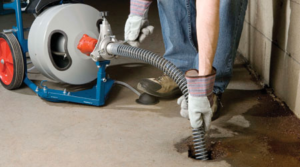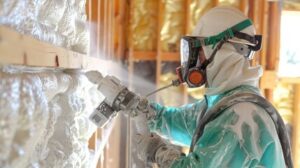Clogged drains can interfere with daily life in a home. But there are several DIY ways to clean them that can help prevent more serious issues down the road.
Store-bought chemical drain cleaners contain harsh chemicals that can damage pipes and cause toxic fumes. These cleaners can also be dangerous to children and pets. Contact Drain Cleaning Perth now!

Chemical drain cleaners are typically liquid products that you pour down a clogged pipe. They work by creating a chemical reaction with the clog to dissolve it. Caustic chemical cleaners contain substances such as lye and caustic potash, which give off electrons to the clog material, breaking it down into smaller pieces that can be washed away. These are most effective on hair- and grease-based clogs.
Acidic chemical cleaners are the harshest of all drain cleaners. They work by releasing sulfuric or hydrochloric acid into the clog to melt and wash away organic materials. These are effective on clogs caused by hair, but may need to be used several times before the clog is fully resolved.
While these liquid products are convenient and relatively inexpensive, they pose a significant health and safety risk. Their caustic properties can damage your pipes and cause chemical burns if they come into contact with your skin or eyes. They also emit harmful fumes that can irritate your nose, throat and lungs.
If you do use a chemical drain cleaner, follow the manufacturer’s instructions for usage and disposal carefully. Most importantly, keep these chemicals out of the reach of children and pets. If ingested, these chemicals can poison your body’s organs, leading to multiple life-threatening conditions. The corrosive chemicals can also harm the environment when they seep into waterways and cause ecological damage.
Another danger of using chemical drain cleaners is that they can actually create more clogs than they resolve. Repeated use can lead to buildup within your pipes, causing them to erode and crack over time. This can cause leaks and other costly problems down the line.
The best drain cleaning method is to prevent clogs from occurring in the first place. Regularly cleaning your drains with hot water and dish soap will help reduce the amount of food waste, grease and other debris that enters your pipes. If you do encounter a stubborn clog, try using a plumber’s snake or one of the other tools mentioned above to break up the matter and restore proper flow.
Plungers
A household plunger is one of the most useful tools a homeowner can have in their arsenal. It can quickly and effectively clear drain clogs and restore full function to your sink, tub, or toilet. However, it’s important to understand that not all plungers are created equal. The size and shape of a plunger’s cup and the material it is made from can have a significant impact on its effectiveness.
There are four primary types of plungers, each designed to tackle different kinds of clogs and drain issues. To ensure you have the right plunger for your needs, it’s important to learn about each type and how they work.
The first thing to consider when choosing a plunger is the type of drain it is being used on. A standard plunger is best for sinks and tubs, while a flange plunger is ideal for showers, toilets, and baths. A flange plunger is similar to a standard plunger, but has an additional rubber flap called a flange that extends outward from the cup to create a better seal.
Regardless of which kind of plunger you choose, it is essential to ensure it is clean and in good working condition. Before using, run hot water over the plunger to soften it and improve its ability to form a seal. Then, examine it for cracks or other signs of wear. If it’s damaged or no longer creating a seal, replace it immediately.
Once you have the correct plunger for your needs, place it over the drain and make sure to seal it tightly. Then, plunge up and down 15 to 20 times continuously. The repeated movement should generate a surge of air and water pressure that dislodges most clogs and allows the water to flow freely.
If you’re still having trouble with a stubborn drain clog, try adding some baking soda to the mix. Pouring this liquid down the drain will help break up clumps of hair and other debris that may be stuck in the pipe. Follow it up with a half cup of vinegar to neutralize the acid from the baking soda, which can damage your pipes over time.
Wire Hangers
Using a wire hanger as a drain cleaning tool is a do-it-yourself (DIY) method that is relatively cheap and convenient. However, it’s important to weigh the pros and cons of this technique before attempting it. Depending on how it’s used, the wire hanger could potentially damage the pipes and lead to further problems.
This DIY solution is ideal for dealing with simple blockages, such as those caused by excessive hair or small food scraps. It’s also a cost-efficient option, as it can be purchased for free and requires minimal skill to use. In addition, it provides immediate results, unlike chemical drain cleaners that may take several hours to work.
To use a wire hanger, simply straighten the end but leave a hook at one side and insert it into the clogged drain. Then, twist and pull the hanger to snag any accumulated debris. Once you feel that the clog is removed, flush the drain with boiling water to clear away any residual residue.
If the blockage recurs, it’s best to call in a professional plumber who can assess and fix the problem. In some cases, the clog can be more severe than what is capable of being dealt with by DIY methods. A licensed plumber can also provide more permanent solutions for persistent drain clogs, such as installing a new drain pipe or replacing an existing section of pipe.
Clothes hangers are rigid and could cause scratches and damage to pipes, especially those made from sensitive materials such as PVC or older metal types. They can also exacerbate a clog by compacting it further into the pipe, making it harder to remove later on.
While a wire hanger can be a good drain cleaning tool for soft blockages, it’s not the best choice for tackling more serious issues. A drain snake or plumber’s auger is more effective and safer for dealing with stubborn clogs. In addition, a wire hanger isn’t suitable for toilets because it can scratch or break the porcelain. This can result in leaks, further deteriorating the drain and surrounding pipes.
Plumber’s Snake
A plumber’s snake, also known as a drain auger, is a mechanical drain cleaner that eliminates clogs without the use of chemicals. The coiled cable has a head with a hook or corkscrew end that breaks up or grips the clog and then twists or pulls it apart, allowing the rest of the clog to wash out of the pipe. This tool is suitable for sinks, bathtubs, and showers. A plumbing snake is more effective than a plunger in most cases, but it’s not a good idea to try to clear a severe clog with one; instead, call a professional for help.
Before using a plumber’s snake, prepare the area around the drain by covering it with old towels. The snaking process can be messy and dangerous, so it’s best to avoid contact with the clog or drainpipe. Once you have the tool ready, remove the p-trap (the curved piping under the sink) if it’s still in place. This will allow you to get the snake into the pipes more easily.
Feed the snake into the pipe, but do so slowly. Pushing too hard could damage the snake’s head or the drain entrance pipe. It’s also important to make sure the snake’s head isn’t too long for the drain.
Once the snake gets close to the clog, run water down the drain to help break it down and move it along. Regularly withdraw the snake to check its progress and remove any clog material it has dislodged. Be patient; snaking can be a time-consuming procedure, especially if the clog is stubborn.
To keep your drains healthy, prevent clogs by putting in place strainers or screens in all of your sinks and tubs. Throw away big food scraps and don’t rinse grease or oil down the drain. Avoid flushing old medicines or toilet paper down the drain, and don’t put anything solid into the toilet except human waste and paper towels.

